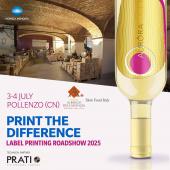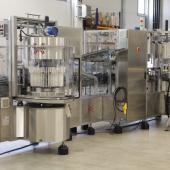The label of the (near) future
A lively panel discussion as part of the annual Finat conference reviewed the situation regarding the market and technological trends in the field of labeling. Here’s what to expect.
More self-adhesive products, greater efficiency of processing cycles, high-speed application, smart and NFC (Near-Field Communication) labels, which not only affect the behaviour of customers but increase the functionality of the labels themselves. These, in brief, the orientations that emerge in the area of labeling, according to participants at the panel discussion on the “battle of the decoration technologies” at the last Finat congress. Orientations that witness the decisive contribution of the machines evolving towards the concept of “open systems” and that are highly flexible in terms of application and automation, evermore important also in the application of shrink labels, one of the segments showing the most growth together with flexible packaging (especially bags and pouches).
On the horizon, however, not only are there emerging growth opportunities, but also developments that threaten the growth of labeling such as, typically, the rise of 3D printing and direct printing of the container. Who will bear the brunt? Everything suggests - experts say - a co-existence of solutions and different technologies, each with their own pluspoints: the ability to “clad” even the most shapes of shrink sleeves, to the infinite variety of self-adhesive products and materials for all needs and all budgets. And here everyone agrees.

Demands (from society) and responses (from the industry)
From the macroeconomic phenomena to sociological dynamics, going into details about particular styles of consumption and the related proposals of the industry, a myriad of continuously changing factors are influencing the concept and the types of label.
During the Finat panel discussion mention was made, for example, of the ever increasing content that the law requires products to bear, stimulating for example the question of flyer-labels - typically with pharmaceutical products, but not only there. Or the needs of interactive marketing, with the development of QR codes and the related technical issues (their legibility on a shrink label requires the commitment of all actors in the supply chain). Or to the growing need for safety that supports the evolution of barcodes and other - to various extent “intelligent” - authentication and traceability systems (RFID in first place).
The operators’ discussion then moved to what everyone considers emerging technologies, starting from linerless labeling that is getting a great response this a bit spread right across all FMCG sectors, and the printing of flexible packaging that once the appropriate changes in thinking have been made, could offer important growth opportunities. Technology suppliers indeed seem to by fully aware of the contiguity between labeling and flexible packaging, as was shown - just to give an example - by the latest developments in digital machines, where HP Indigo has just unveiled a printer for paper and film rolls up to 750mm wide, suitable for flexible packaging. Lastly, the crucial subject of the price sustainability ratio, and hence the efficiency of the production line, was raised, and this along with the need to respond to the demands of eco-sustainability, the development of ever thinner material (and the machines capable of processing them), plus the emergence of a recent technology for separating sleeve from the container which facilitates PET recycling.
A complex achievement
Product label is not just a matter of printing. It is a process that concerns a complex chain of values that starts from the material to be printed and comprises the machinery used, whatever technology may be applied. This was discussed with lively participation, during a panel debate dedicated to the “battle of technology decoration”, organized by Finat as part of the last annual conference (Monte Carlo, 5-7 June 2014). The proof? Representatives of the entire chain were involved in the debate: Stefan Richter from Krones (processing machines, filling, labeling), Geert-Jan Kolkhuis Tanke of Avery Dennison (label materials), Raul Matos, founder of Karlville Development LLC (equipment for the processing and application of shrink sleeves and bags), Marc Büttgenbach, Bizerba sales director of labels and consumables, as moderator. And the public posed questions and considerations, helping to enrich the discussion with the most concrete of subject matter. Finat is the international federation of manufacturers of self-adhesive labels and related products. It dedicated the June Congress to the theme “The struggle for shelf visibility. Winning Strategies for the label industry”, faced by broaching key matters on both the technical and the marketing front. And a “treat” at the end: the intervention of the famous Swiss explorer and balloonist Bertrand Piccard. Who taught people how to fly.




















